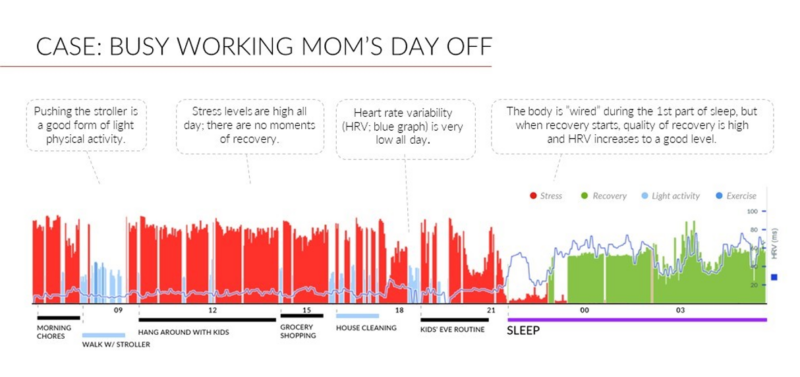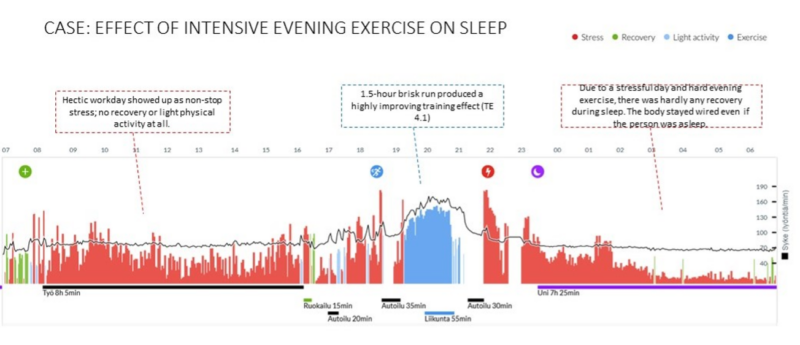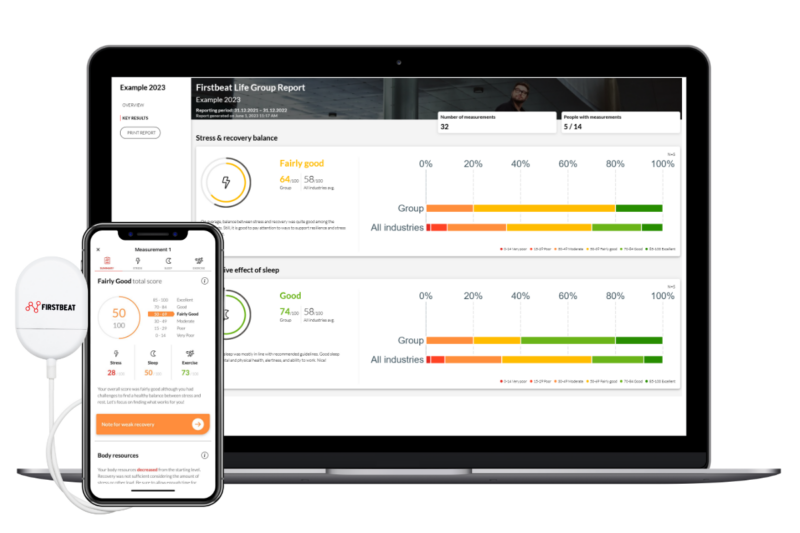
In this blog, I will discuss two fairly typical Firstbeat Life cases by sharing “the story behind the data”, a few highlights of the result, as well as action points set by the coach and the client. The idea is to highlight how different the results of different individuals can be, depending on, for example, genetic influences, general health, and overall life situation. The essence of the coaching process is to understand the context during the measurement, the client’s subjective feelings, and various realities related to their life situation – and then utilize the data to make a sustainable, realistic plan for next steps. Data is often “just a conversation starter”, but it can add immense value and depth to the coaching discussion by bringing out concrete insights from real life.
CASE 1: Busy Mom With a Full-time Job
The 1st case is a 35-year-old woman who has 3 small children and a demanding full-time expert job that requires some evening work due to her team being in different time zones. She has been physically quite inactive during the last couple of years due to her busy life situation. She contacted a PT specifically with the hopes of getting fit and back to a regular exercise routine. She also admitted feeling very fatigued at times. The PT suggested starting out with a Firstbeat Life measurement to get a comprehensive view of her situation.
The Firstbeat Life result showed a lot of stress and less recovery than recommended on all the measured days. There was very little daytime recovery, and recovery during sleep was delayed, although at quite a good level for most of the sleep period. Looking at her result, she said she had expected her sleep to be even worse and commented that she often feels so busy and wired that it’s difficult to slow down or relax. She was pleased to see that walking with the baby stroller showed up as light physical activity and provided moderate health benefits (Fig. 1).
Action points and next steps
Related to recovery, the main action point set together with the coach was to start scheduling a few relaxing breaks during the day (and marking them in her calendar to make sure they did not get swept under her busy schedule). She was going to experiment with a few different relaxation activities to see what works best for her.
To improve her fitness, the plan included:
- 1 guided gym session per week to help with her motivation and commitment.
- Simple home exercise routine two times per week (can be done even when at home with the kids).
- Continue with regular stroller walks as a good form of basic endurance exercise.
The plan is monitored and updated as needed during the weekly PT meeting and with another Firstbeat Life measurement in 1-2 months to see if she has been able to improve her recovery. They felt that this program would gradually improve her fitness, without overloading her in her current, busy life situation.

Fig. 1. This result from her day-off is representative of her workdays, too. A lot of non-stop stress, no daytime recovery, but fairly good sleep.
CASE 2: Effect of Intensive Evening Exercise on Sleep
This case is a 50-year-old financial consultant whose work is physically light, but mentally demanding. He typically exercises just once per week by going on a run during his child’s football practise. He took part in Firstbeat Life as part of an age group -based occupational healthcare check. Overall, he feels quite well, but expected to see a fair amount of stress, acknowledging that his lifestyle could be better.
Learn more about Firstbeat Life for health and wellness professionals→
His workdays showed up as continuous stress (see day 1 in Fig. 2). On the positive side, some recovery (green) was seen in the morning before his remote workday started and while eating after work. The 1.5-hour run in the evening was so intensive that it left the body’s activation level elevated (showing up as stress) all night, with essentially no recovery during 7.5 h of sleep. The daytime graph looked very similar on the other measured days, but recovery during sleep was a bit better, turning into recovery during the 2nd half of the night. The physical activity points and step counts were very low on the other measured days.
Action points and next steps
Considering his currently low activity level, the specialist recommended lowering the intensity of his evening run or alternating running with walking to keep the heart rate level lower. Only exercising once per week, but doing it so intensively overloaded his body and had a dramatic effect on his sleep quality. It can even be a health risk to only exercise once per week but do it at near-maximal intensity. To build a stronger endurance base, they agreed that he should start adding some light activity into most of his days (e.g., taking the stairs, walking meetings, short walks whenever he can). Regular physical activity will also help his stress management and recovery – and will eventually make it easier to handle the hard evening run. They agreed to monitor his situation with a few measurements on different types of days, including a day-off, to see how the recovery situation develops, especially during sleep.

Fig. 2. A stressful day, followed up with very intensive exercise in the evening. This caused an acute overload, and his recovery was poor even during sleep (high heart rate, stress level gradually dropped but did not turn into recovery).
There is no one right way to interpret a specific Firstbeat Life dataset because it depends so much on the client’s life situation and wishes regarding what they feel is most relevant for them. The coach’s job is to listen, offer suggestions, and in some cases, strong recommendations. The data can guide the conversation, and in addition to bringing out problem areas, it often highlights some positives that can boost the client’s motivation – “things aren’t quite as bad as I thought”, as seen with the busy mom and her sleep data. For continued learning and monitoring the effectiveness of set plans, it’s recommended to repeat the measurement at least a few times, during different days and by testing the effect of specific actions.
Accurate physiological data allows you to understand your clients’ wellness status and identify potential health risks and make better coaching decisions. It helps you to deepen and lengthen your client relationships. Learn more about Firstbeat Life.
If you liked this article, you should subscribe to our newsletter.
You might also be interested in

Supporting Your Clients to Make the Most of Their Firstbeat Life Experience – Measure and Learn
To wear or not to wear…? Sensible use of wearable devices is an important consideration for coaches who want to utilize data to add depth to their programs and motivate…

What Can Physiological Data Reveal About Your Clients?
Accurate physiological data allows you to understand what is really going on in a client’s life and reveals the effects of their daily choices on their overall well-being. It can…

Firstbeat Life Featured in New Podcast The Energy Equation
Learn how Oliver Patrick uses Firstbeat Life in his interviews with celebrity guests on this fascinating new podcast. Firstbeat Life is featured on the new Energy Equation podcast that sees…



